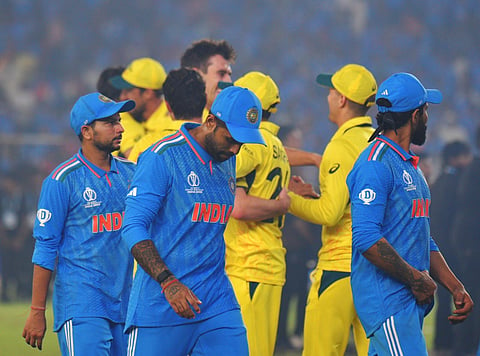

AHMEDABAD: A brand new stadium. A wave of nationalism with sport meant to unify a nation. An expectant crowd. Previous results showcase their widespread arsenal.
The similarities between Sunday and July 16, 1950, may be exhaustive but parallels can still be drawn. That day, some 200,000 locals in Brazil crammed into the Maracana to watch on as the national football stadium faced hitherto unfancied Uruguay. The hosts were favourites by such a margin that the mayor had announced Brazil would emerge winners of the football World Cup an hour before kick-off. Uruguay won 2-1 and the 'Maracanazo (Blow of Maracana)' was born.
So, did the cricketing world witness its own Maracanzo on Sunday? Moterazo, perhaps? While it's impossible to tell what sort of effect the defeat would have on the nation's psyche — people in Brazil still keep talking about that 73 years later — on the morning after the night before, the Indian team would go down as one of the best to have never won the World Cup.
They had come together as one a year before the World Cup. Over the last 45 days, they have beaten teams, gone on a dizzying 10-match winning run and, importantly, got the buy-in from the fans.
On Sunday, the jenga came crashing down. Multiple pressure points led to the carefully assembled block collapsing in a heap. For the past two years, Rohit Sharma has been talking about a batting blueprint where aggression would trump all else. He stayed true to his word and eliminated the slowness of the pitch from the equation with a 31-ball 47. On a surface taking a slow turn and next to no bounce, this was a marker inside the powerplay.
But India's first big error had come when Rohit admitted at the toss that they would have opted to bat anyway. Surfaces in Ahmedabad have tended to get better for batting in the evening. That was the case in the very first match of the tournament when New Zealand had made light work of England where they chased down 283 inside 37 overs. This city has had lots of dew in previous games and Australia had already seen it up front. They had restricted England to 253 when defending 286.
In the pre-match press conference, Cummins had referenced it. "The biggest difference is the dew," he had said. "This city and venue seems to have more dew than a lot of other places we play. So, perhaps, that's something to think about. It might only be the last quarter of the game but once that settles in and the ball is sliding on it's quite different to say the first 20 overs where it might be swinging." True to form, the dew arrived and once it arrived, there was an element of the ball skidding off the strip, something that was missing in the first innings.
Sussing out the pitch is only half the battle. You still have to execute pre-decided plans. Cutters, hard lengths, slower ball bumpers... Cummins and Josh Hazlewood were at it throughout the middle-overs. On a sticky wicket with no bounce, run-scoring was going to be difficult.
But was it four fours across 240 legal deliveries difficult (India managed only four hits to the fence after the first powerplay). This is why Shreyas Iyer's wicket swung the pendulum towards the visitors. Virat Kohli and KL Rahul are a fine partnership pairing — they had shown that against Australia in this tournament before — but do you want them setting a target?
Iyer and Kohli are different because of what the former brings to the table. He takes risks more readily while Rahul is the kind of batter who explodes at the back end. The stats bear this out. In the middle overs, India went at a run-rate of 3.9. A stark difference to their tournament run rate of 5.7. A major reason for that was Iyer was batting with Kohli in a lot of games. The pair had combined for 542 runs as a partnership alone over the last 45 days. Were Rahul and Kohli a touch defensive?
They faced six overs off-part time nothing pace and something spin from Travis Head, Glenn Maxwell and Mitchell Marsh, scoring 20. There wasn't a single shot in anger as both players didn't line up to take them down.
Coach Rahul Dravid spoke about how hard the conditions were. "I think we fell about 30-40 runs short," he had said. "I thought they bowled well through that period. I thought it just felt like the ball was stopping in the afternoon a little bit more than it did in the evening. There was that period where I think the ball was stopping. We weren't able to get boundaries. We were rotating the strike, but we weren't able to hit those boundaries. There was a conscious effort to try and take the game deep, but we kept losing wickets. We just lost wickets just when we felt that we built a partnership and we can start going."
Coming to the bowling attack, India moved away from their plans for the first time all tournament. Going to Mohammed Shami — he has had issues controlling a new ball previously — over Mohammed Siraj looked like a sort of hail mary when a sense of calm was what was needed. By the time Siraj was introduced into the attack, they had already knocked off 30 per cent of the runs.
By that time, the beginning of the end was in sight.